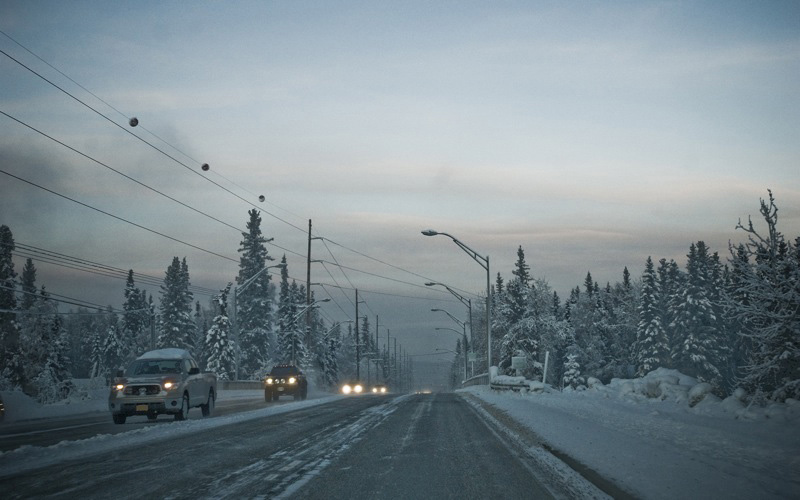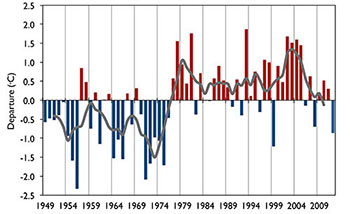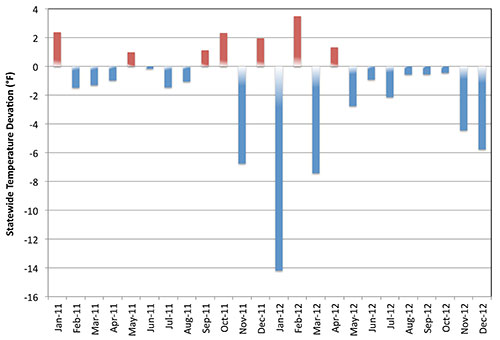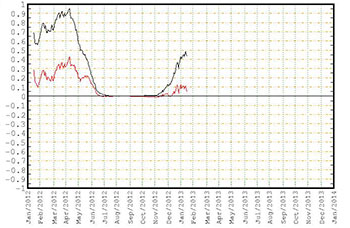Yes, Virginia, it was cold somewhere
During the nation’s warmest year on record, Alaska was a contrarian
Jan 15, 2013 - by Staff
Jan 15, 2013 - by Staff
Bob Henson • January 16, 2013 | Even as the rest of the nation baked in 2012, Alaska froze. The contiguous 48 U.S. states saw their warmest year by far in records that go back to 1895. Yet it was Alaska’s 11th chilliest year in 95 years of recordkeeping, according to NOAA’s National Climatic Data Center. (Scroll to “Alaska Annual Summary” in the NCDC’s State of the Climate 2012 report to learn more.)

Faint midday light illuminates Fairbanks on December 28, 2008. The low temperature that day was –40°F, which is also –40°C. (Wikimedia Commons image by D. Sikes.)
Because Alaska and Hawaii are so distant from the rest of the country, and their weather records don’t date back as far, the two states aren’t factored into most analyses of national temperature rankings and trends.
It’s also very difficult to compile a meaningful average for an enormous, sparsely populated region such as Alaska. For this reason, the Alaska State Climate Center chooses not to calculate statewide mean temperatures.
“It is apparent, however, that the winter of 2012 was one of the most severe in Alaska history,” says the center’s director, Peter Olsson. Conditions were not only frigid but extremely snowy well into spring (see photo below).

Alaska’s overall warming trend in the last few decades hasn’t been uniform. This graph shows departures from the 1949–2013 average in degrees Celsius. Temperatures were cooler than average in the 1950s through 1970s and then rose sharply, with a new tendency toward cooling under way in the last decade. (Graph courtesy Gerd Wendler, Alaska Climate Research Center.)
The town of Bethel, near the southwest Alaska coast, saw its fifth coldest year in records dating back to 1949, with an average temperature of 25.6°F(–3.6°C).
In Fairbanks, an impressive stretch of cold ended on Christmas Eve: temperatures stayed at or below –30°F (–34.4°C) for four solid days, and the mercury dipped below –40°F (–40°C) for nine consecutive nights. By New Year’s Eve, Fairbanks had jumped back to a relatively balmy 34°F (1°C).
Impressively and tellingly, not a single record was broken in Fairbanks during its bone-chilling December. Setting a record low in this icy realm takes some effort.
Last year’s chill in Alaska runs counter to overall global warming, which is strongest in the far northern and far southern latitudes. (This includes West Antarctica, as confirmed in a recent study by scientists from Ohio State University, NCAR, and the University of Wisconsin–Madison.)

An unusual sight near sea level in July: Snowdrifts sit along a highway near Cordova, in the Copper River Delta of Alaska’s Prince William Sound, on July 4, 2012. It was the first time in recent memory that drifts of this size were seen to persist in the region well past May. (Photo by Peter Olsson, Alaska State Climate Center.)
Researcher Gerd Wendler and colleagues (Alaska Climate Research Center) opened the aperture on Alaska temperature a bit further in a paper this autumn entitled “The First Decade of the New Century: A Cooling Trend for Most of Alaska,” published in the Open Atmospheric Science Journal. The study focuses on “first-order” NOAA weather stations, which are top-of-the-line stations scattered across the state. “The coverage is not perfect, but it is not bad either,” says Wendler.
Though Alaskan temperatures have been above normal for most of the period since 2000, several years that were sharply colder than average are sprinkled into the mix. The decade’s overall cooling trend was sharpest in winter, followed by spring.

In this month-by-month graph, unusually cool temperatures in winter and spring account for the most dramatic below-normal readings observed in Alaska during 2011 and 2012. Departures from normal are shown in degrees Fahrenheit. (Graph courtesy Gerd Wendler, Alaska Climate Research Center.)
What’s up? As with any trend, the interval makes all the difference. “Whether there is warming or cooling depends strongly on the time scale,” notes Wendler.
There’s no doubt that Alaska is heating up over the long term, as the Wendler paper emphasizes. Fairbanks—one of the state’s few stations with a 100-year record—has warmed by about 2.5°F (1.4°C) over the last century, nearly double the global pace. Statewide, long-term warming mirrors the seasonal pattern noted above for more recent cold departures: it’s strongest in winter, followed by spring (see chart above).
Wendler’s paper pins the colder-than-normal years of late on the regional weather-maker known as the Pacific Decadal Oscillation, well known as a major player in Alaskan weather. He and colleagues find that more than half of the state’s 2000–2010 cooling trend can be attributed to a largely negative PDO, which signals the presence of circulation patterns that draw cold air southwest across Alaska.

During the last two winters, sea ice area in the Bering Sea (black line) has been consistently above average. The red line shows whether sea ice area is above or below the daily mean, calculated for the period 1979–2008. Units are millions of square kilometers. (Image courtesy Cryosphere Today, University of Illinois at Urbana-Champaign.)
Though it’s not addressed in the Wendler study, sea ice was unusually extensive across the Bering Sea last winter. This reflected, and perhaps helped reinforce, the colder-than-normal conditions observed across western Alaska. Much the same is happening now, with ice extent across the Bering Sea again running above average (see graph at right).
It’s not yet clear why Arctic sea ice is so widespread toward Alaska while it’s so depleted on the other side of the ocean, north of Scandinavia. Wendler is now working on a paper that will examine Bering Sea ice trends.
“Gerd did an interesting study,” says state climatologist Peter Olsson (Alaska State Climate Center). Like Wendler, he stresses the importance of time scale. “Should we say that Alaska is now cooling? Over the last 10 years, perhaps yes. Over the last 30 years? 50 years? Most likely not.”
Even if the century-scale forecast for Alaska is solidly in the warming camp, unpredictable swings of the PDO and other quasi-cyclic phenomena make it hard to know what the state should expect over the next few years. Olsson isn’t holding out hope that useful multiyear climate predictions for the region will take shape anytime soon. However, he says, “I think we stand to learn much in the basics of climate dynamics by understanding the various cycles that seem to be at play.”